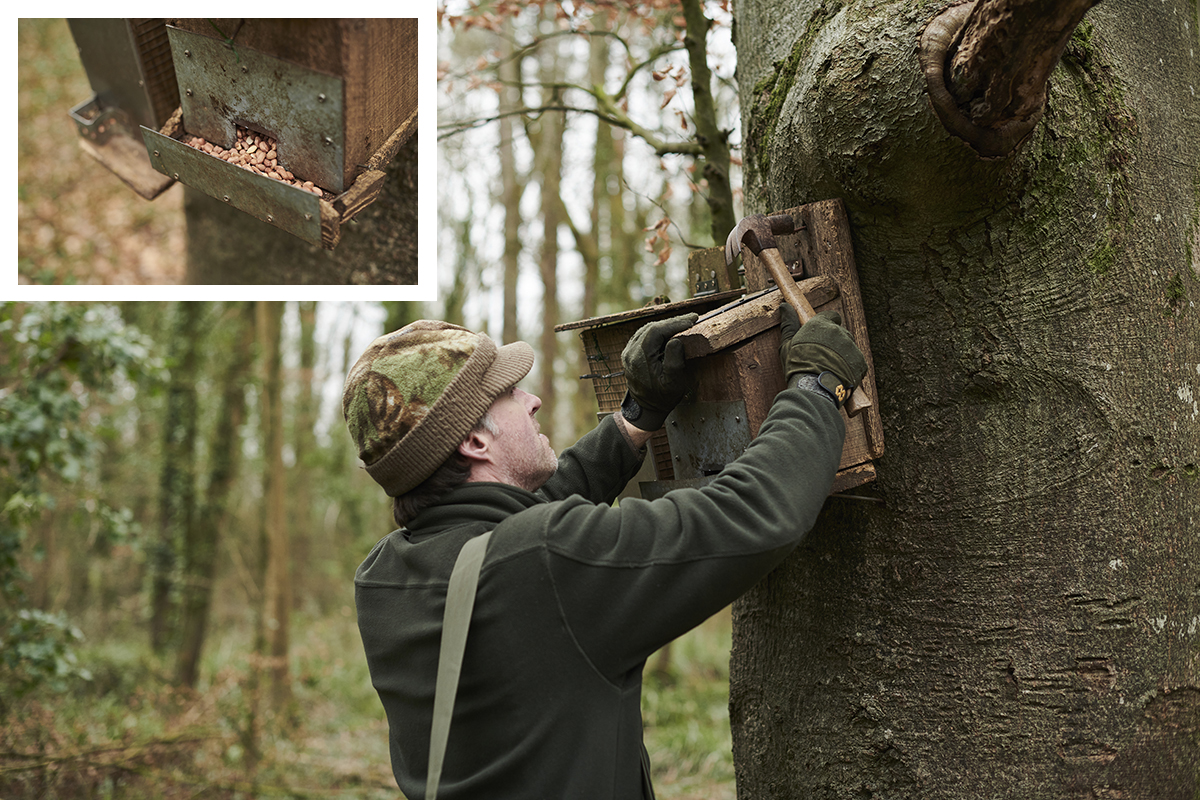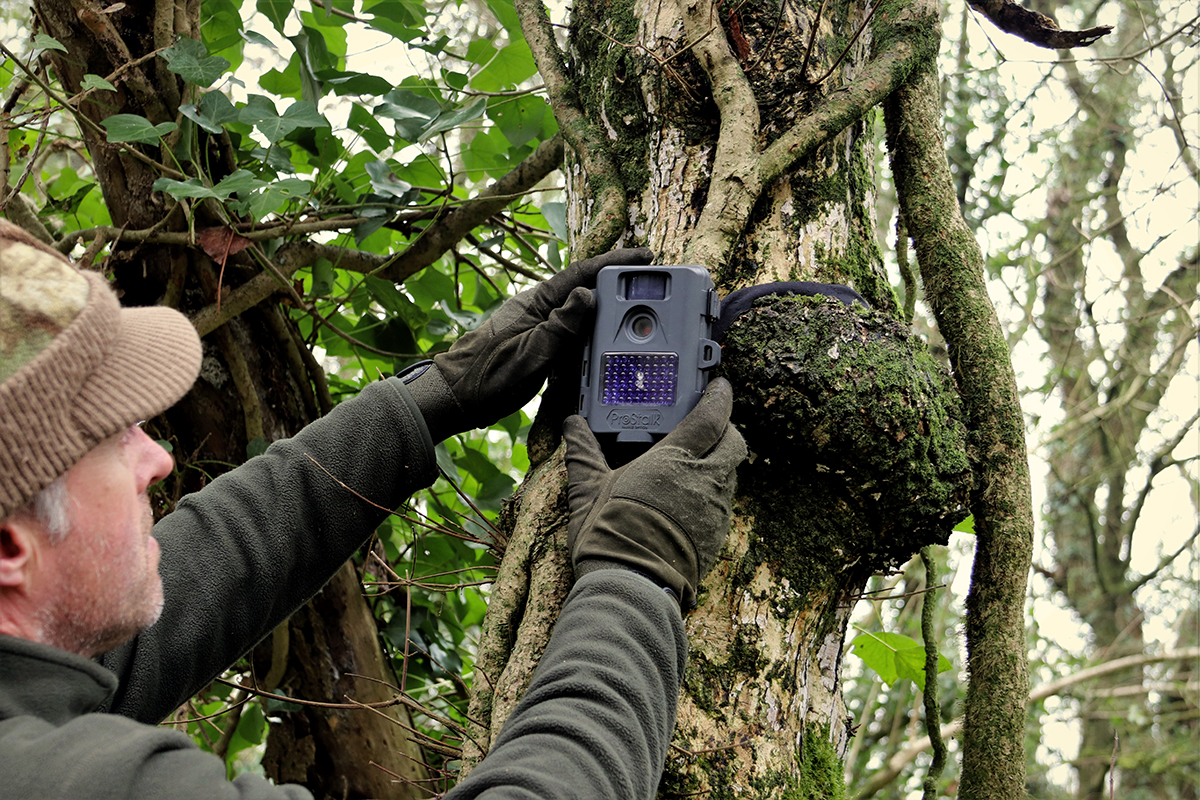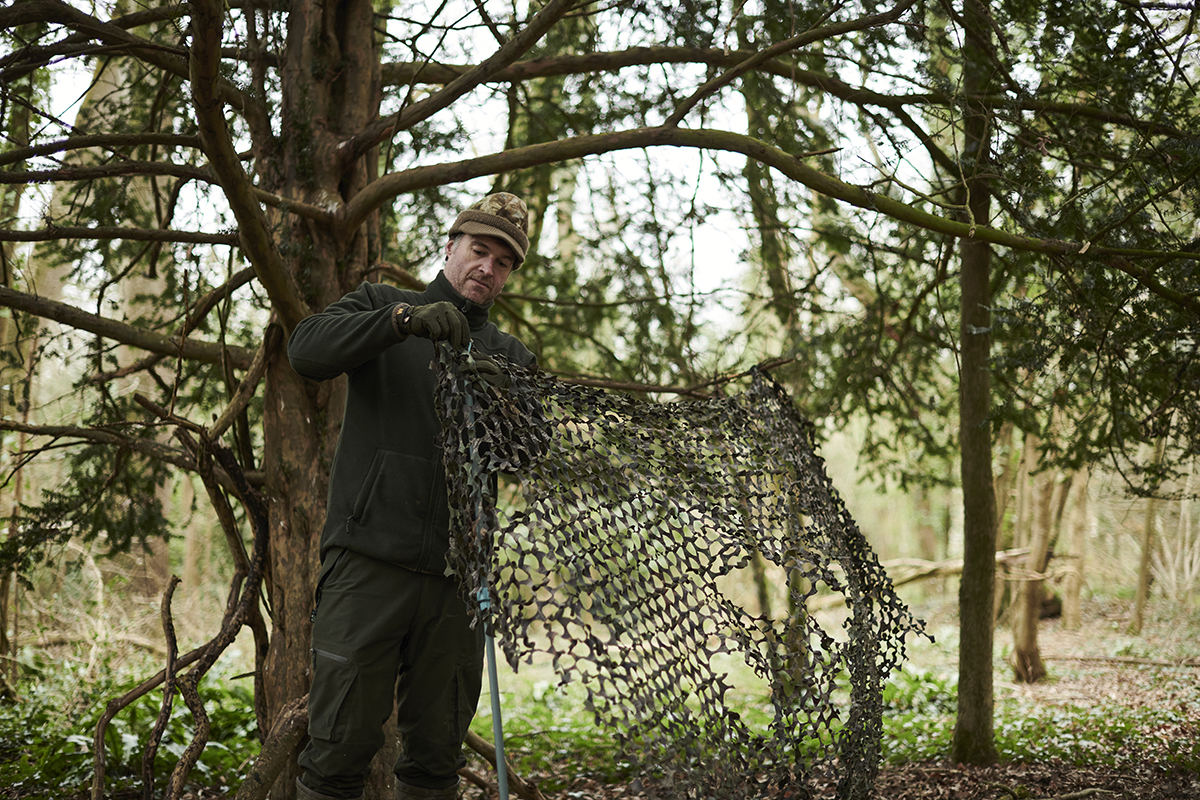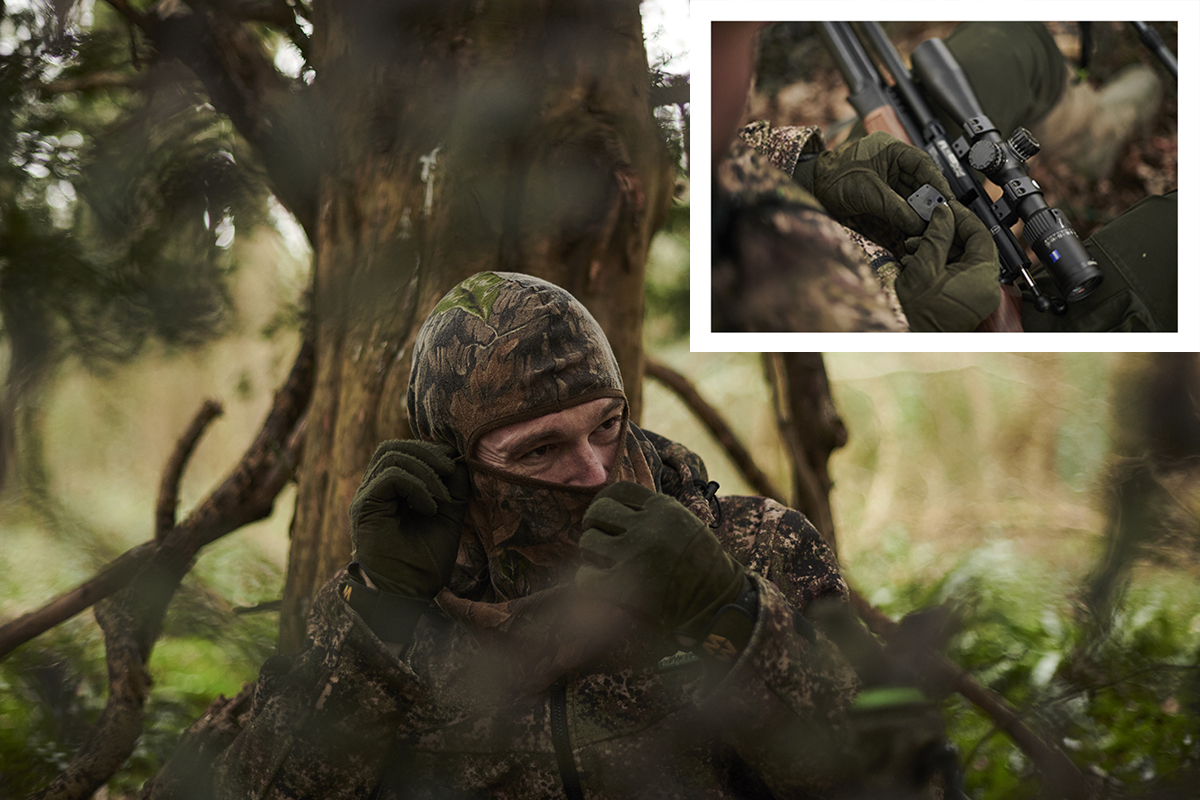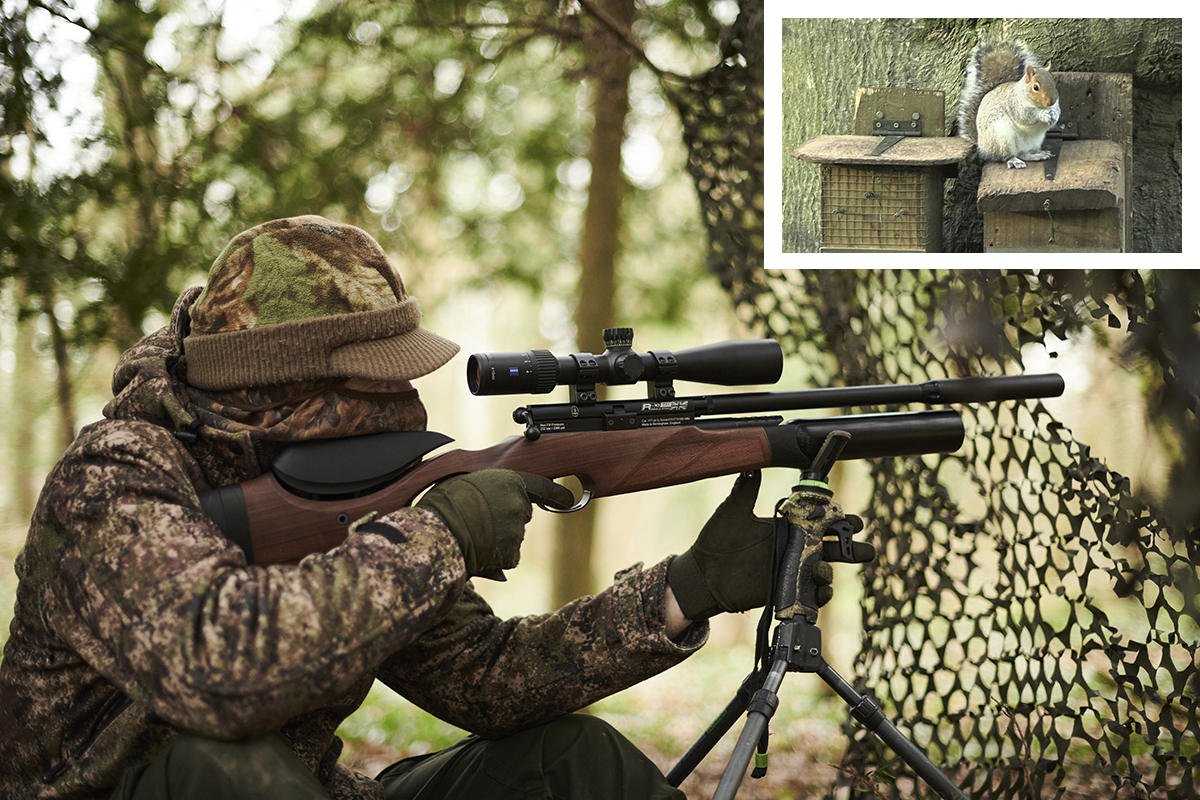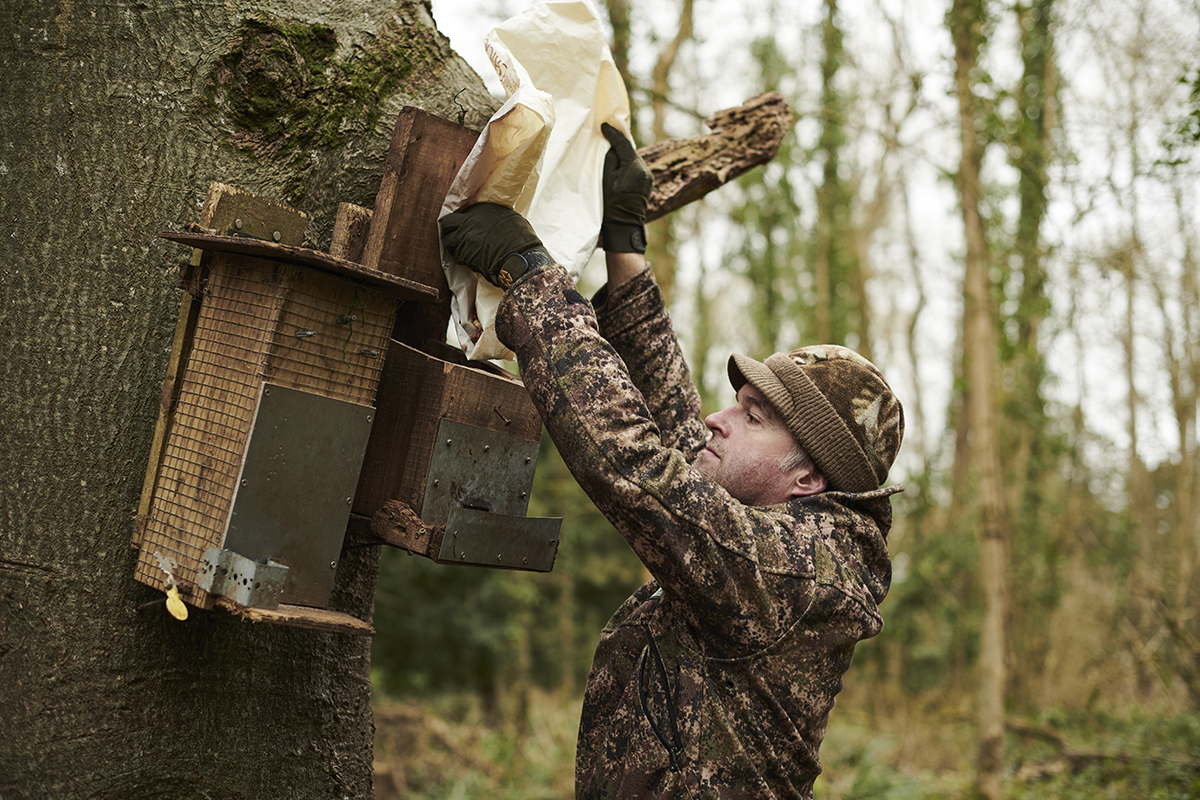Win CENS ProFlex DX5 earplugs worth £1,149 – enter here
Using a bait trap for grey squirrel control
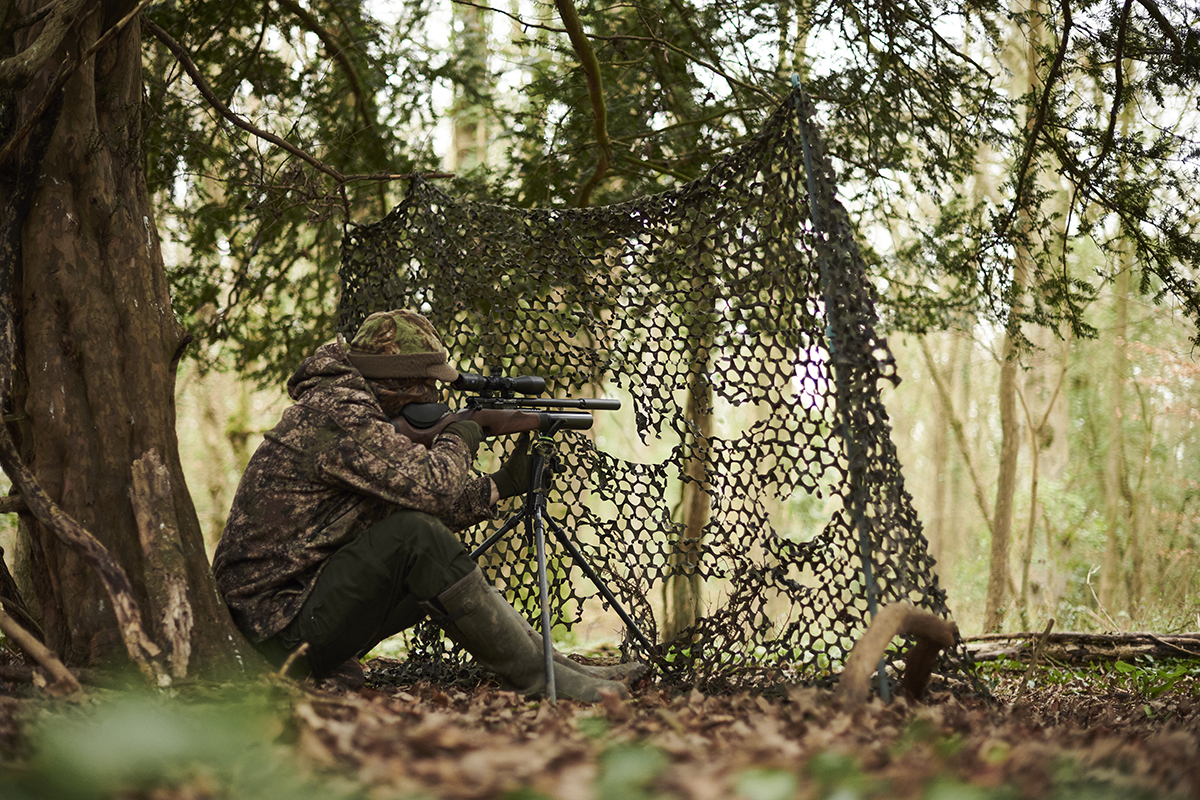 Countryman Squirrel Control With Mat Manning
Countryman Squirrel Control With Mat Manning
Controlling grey squirrels is a job that needs to be done right through the year if you are going to make a dent in their numbers – and keep them down. The methods we use can vary from season to season, but there is no denying that setting up a feeding station to use as a bait trap is one of the best whatever the time of year.
I didn’t actually use my feeding stations very much through the winter on one woodland permission. This is because the wood is managed as a pheasant shoot and I can expect to encounter plenty of grey squirrels around the pheasant feeders during the colder months when natural food is scarce.
Things are changing now. With the pheasant season long behind us, the gamekeeper is putting out less grain for his birds. This, combined with the increasing abundance of natural food, means that the squirrels are spreading out more.
Rather than adopt a roving approach and trying to pick off any squirrels when I encounter them, I am re-establishing one of my feeding stations in order to create an area of high attraction.
Grey squirrels can’t resist an easy meal, so it should be a reliable way to keep the cull on track.
And now is an important time to be doing that, because these relentless pests do most of their destruction to trees and nesting songbirds during the spring months.
The quarry: grey squirrel
Pest status: This invasive rodent damages trees, contributes to the decline of red squirrels, and preys on the eggs and chicks of songbirds.
Habitat: Squirrels spend much of their time in the trees, although they will also forage on the ground.
Additional info: Grey squirrel meat is surprisingly good to eat. Fishermen also use their tail fibres to tie fly-hooks.
Ten days before shoot: setting up the feeder
Grey squirrels usually home in on a free meal, but it pays to put your feeder in the right place. Keeping to a few guidelines will usually ensure that it’s in a hotspot. Mat has seen plenty of squirrels in this area, so he knows they are present. Several dreys in the vicinity are a good sign.
The tree Mat has attached his feeders to has branches that connect to several other trees. Trees like this are usually more productive than isolated ones as the interlocking branches save squirrels from having to travel across the ground.
Very importantly, the feeders are high enough off the ground to keep them out of reach of deer, and are positioned where Mat will have a clear view of them from his intended hide site about 25m away.
Mat has permission to nail his feeders to this tree, but always check with landowners in case they would prefer you use rope. As a former chainsaw operator, Mat knows the importance of removing nails when feeders are taken down.
Peanuts are the bait of choice for this assignment as squirrels find them irresistible, even when natural food is abundant. Mat has opted to use two feeders to reduce the number of visits he needs to make to keep them topped up.
Ten days before first shoot: setting up trap cams
A trail camera is not essential for grey squirrel control, but can prove useful for surveillance. Intel from your camera will inform you of visits from squirrels, songbirds and less welcome guests.
It hasn’t been a problem on this permission, but Mat has had feeders vandalised in the past. Apart from catching the culprit, the presence of a trail camera is often enough to discourage misinformed vigilantes. Set up fairly close to the feeding station, the camera should also be triggered by grey squirrels when they turn up to dine.
Most trail cameras can stamp images and video with the date and time, which can give a great insight into your quarry’s behaviour. By noting the times at which squirrels are most likely to visit the feeders, Mat has been able to establish the most productive periods of the day to spend in his hide. With the feeders and camera up and running, Mat heads for home and won’t return for three or four days. The best thing he can do now is leave the area in peace so birds and squirrels can find the feeder and, in turn, attract more squirrels to the food source with their comings and goings.
Check out our list of the best trail cams for hunting
Four days before first shoot: building the hide
Mat’s usual approach when using feeding stations is to wait a week to gauge the response from the squirrels, and then build a hide if they appear to be making regular visits.
If the feeder is getting plenty of activity, Mat will then go ahead and build his hide and keep the feeder running for another week so the squirrels continue to grow in numbers and in confidence before he begins to shoot.
The rate at which the feed is going down, along with the very frequent squirrel visits captured on his trail camera, are enough to convince Mat to move a little quicker than usual on this occasion. There is no doubt that plenty of squirrels are tucking into the peanuts, so he wants to thin them out before feeding them starts to get expensive.
Although the squirrels are likely to be very distracted by the peanuts, Mat is building a simple hide to help keep him out of sight. He has chosen a site beneath an old yew tree that provides plenty of shade and has propped up a camouflage net with some hide poles to create a screen in front of where he will be sitting.
After pegging the base of the net to the ground with sticks to stop it from flapping in the breeze, Mat refills the feeder before leaving the woods. He will be returning with his airgun in a few days.
15:35: get set for action
Preparation is everything when it comes to making successful hits from feeding stations. The response to Mat’s feeders suggests that squirrels have arrived in force, but there are still a few steps to take to make the most of the opportunity.
Waiting for long periods in a hide can get uncomfortable, so Mat brought along a beanbag seat. Apart from serving as a dry cushion to sit on, a bag filled with polystyrene balls moulds to the ground to create a very stable shooting platform.
Mat’s shots will be getting even more support from his shooting sticks, which will help him to hold a rock steady aim.
His Primos Trigger Sticks are height-adjustable, making them perfect for today’s sitting position, and also for kneeling and standing shots.
The final preparations of the session see Mat loading up his magazine and pulling on his camo headnet. Even with the cover of the hide keeping him concealed and the distraction of the peanuts, Mat doesn’t want to blow his chances by skimping on camouflage. (What is the best camouflage pattern for airgunning? Read more here).
Mat has done as much as he can to swing the odds in his favour. The groundwork is complete, and all he can do now is sit back and await the squirrels’ response.
Looking for camouflaged hunting gear? Check out our list of the best camouflage jackets
Mat Manning’s expert tip: give it time
It can be very tempting to start shooting as soon as you see the first signs of squirrels visiting your feeding station. It pays to be patient though, as more greedy bushy-tails will come if you give them time.
Songbirds are usually the first visitors to a feeding station loaded with peanuts or maize. They will soon attract the attention of squirrels, which will in turn attract their inquisitive mates when they notice the activity around the feeder.
Mat’s usual approach is to wait a week to confirm that squirrels are visiting before building his hide. He then gives them another week to grow in confidence and numbers before the shooting commences.
15:55: fast food
Just 20 minutes after Mat settled into his hide, a squirrel clambers down the tree and heads straight for the feeders. The cocky rodent helps itself to a peanut and hunches on top of one of the hoppers to nibble at the nut.
A great thing about using a feeding station is that you are presented with a static target over a known range and are shooting from a comfortable position. These combined factors really help when it comes to achieving clean kills.
Mat knows this squirrel is 25m away and he hardly has to move to frame it in his sight picture. With the support of the shooting sticks, the crosshairs quickly settle on the unsuspecting squirrel’s skull and Mat squeezes off the shot to drop it with a whack to the head.
With the first squirrel accounted for, Mat wastes no time in reloading ready for the next. And he doesn’t have to wait long until another one slinks down the tree. This squirrel is more cautious, but soon gives in to the lure of the bait and settles on top of the feeder to devour a peanut. Mat delivers another precise headshot before it even has time to get the husk off.
18:20: wrap up and refill
Even squirrels that have had time to grow very confident around a feeding station can become unsettled when confronted with the sight of dead comrades. It can sometimes be worth breaking cover to retrieve shot squirrels, but then you run the risk of causing even more alarm to any unsettled stragglers.
The third squirrel to show up today was clearly spooked by what it saw on the ground, but it was still determined to get a peanut. After creeping back up the tree on its first couple of approaches, it finally reached the feeder and stopped to tuck in.
Although Mat had a few fleeting chances to shoot this squirrel while it was making its mind up, he held steady and waited for it to commit to the bait. Consequently, he was rewarded with a much easier shot at a squirrel that wasn’t likely to move at the critical moment. The result was another squirrel on the deck.
After almost three hours in the hide, Mat’s final total is 11 squirrels. That may sound like a big tally but it is not exceptional for a first session on a productive feeding station.
Activity has now come to a grinding halt, so Mat has decided to draw today’s shoot to a close. He concludes by refilling the feeders, ready for his next visit in a few days’ time.
Mat’s gear
GUN
BSA R-10 TH
bsaguns.co.uk
SCOPE
Zeiss Conquest V4
zeiss.ly/v4-scopes
AMMO
Rangemaster Sovereign
daystate.com
JACKET
Ridgeline Grizzly III Jacket
ridgelineclothing.co.uk
GLOVES
Macwet Long Cuff
range-right.co.uk
STICKS
Primos Trigger Stick Tripod
bisley-uk.com
Related Articles
Get the latest news delivered direct to your door
Subscribe to Shooting Times & Country
Discover the ultimate companion for field sports enthusiasts with Shooting Times & Country Magazine, the UK’s leading weekly publication that has been at the forefront of shooting culture since 1882. Subscribers gain access to expert tips, comprehensive gear reviews, seasonal advice and a vibrant community of like-minded shooters.
Save on shop price when you subscribe with weekly issues featuring in-depth articles on gundog training, exclusive member offers and access to the digital back issue library. A Shooting Times & Country subscription is more than a magazine, don’t just read about the countryside; immerse yourself in its most authoritative and engaging publication.






